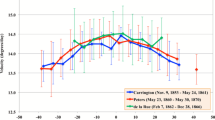Summary
The procedure of determining the equatorial radius of the Earth is briefly described and the problem whether the equatorial radius of the Earth is a primary constant, a derived constant, or a defining constant is discussed from various points of view.
Similar content being viewed by others
References
T. Fukushima: IAU-WGRS/SGAC Circular No. 14, 1990.
T. Fukushima: IAU-WGRS/SGAC Circular No. 12, 1990.
H. Moritz: Geodetic Reference System 1980, Bulletin Géodésique,58 (1984), 388–398.
W. A. Heiskanen, H. Moritz: Physical Geodesy, W. H. Freeman, San Francisco, 1967.
C. A. Murray: Vectorial Astrometry, Adam Hilger Ltd, Bristol, 1983, p. 69.
Author information
Authors and Affiliations
Additional information
Contribution to the I. A. G. Special Commission SC3 Fundamental Constants (SCFC)
Rights and permissions
About this article
Cite this article
Kinoshita, H. Is the equatorial radius of the earth a primary constant, a derived constant, or a defining constant?. Stud Geophys Geod 38, 109–116 (1994). https://doi.org/10.1007/BF02295907
Received:
Revised:
Published:
Issue Date:
DOI: https://doi.org/10.1007/BF02295907




